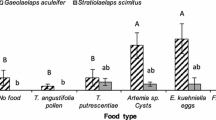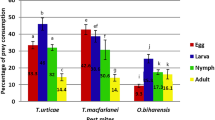Abstract
Amblydromalus limonicus Garman & McGregor (Acari: Phytoseiidae) is a generalist predatory mite with economic potential to control thrips and whiteflies in protected cultivation. We tested the development and reproduction of A. limonicus on three food sources with potential for use in laboratory production or to support its populations in a crop: fresh cattail pollen, Typha latifolia L. (Poales: Typhaceae), dry decapsulated cysts of the brine shrimp Artemia franciscana Kellogg (Branchiopoda: Artemiidae) and frozen eggs of the Mediterranean flour moth, Ephestia kuehniella Zeller (Lepidoptera: Pyralidae). The diets were tested both on an artificial substrate and on kidney bean leaves. In the absence of food, all larvae died on the artificial substrate, whereas they succeeded in reaching the protonymphal stage on bean leaves. Immature survival was high (>90 %) on all diet–substrate combinations, except when E. kuehniella eggs were offered on the artificial substrate (35 % survival). Both sexes showed the fastest development when offered E. kuehniella eggs on leaf discs, followed by A. franciscana cysts, whereas the slowest development was achieved on T. latifolia pollen. Fecundity and oviposition rate were higher on E. kuehniella and A. franciscana than on T. latifolia. Amblydromalus limonicus females lived longer on the leaf discs than on the artificial substrates. The intrinsic rate of increase (rm) was highest when E. kuehniella eggs were offered on leaf discs (0.256 females per female per day), whereas the lowest rate (0.128 females per female per day) was obtained when the eggs were provided on artificial substrates. The intrinsic rate of increase on A. franciscana cysts was not affected by substrate and averaged 0.22 females per female per day. Diet significantly influenced the size of A. limonicus females as measured by the distance between specific setae on the dorsal shield of the idiosoma. The application of the investigated food sources to sustain a colony of predatory mites upon their release in a greenhouse crop is discussed.

Similar content being viewed by others
References
Arijs Y, De Clercq P (2001) Rearing Orius laevigatus on cysts of the brine shrimp Artemia franciscana. Biol Control 21:79–83
Bakker FM, Klein ME (1992) Transtrophic interactions in cassava. Exp Appl Acarol 14:293–311
Birch L (1948) The intrinsic rate of natural increase of an insect population. J Anim Ecol 17:15–26
Bolckmans K, van Houten Y (2006) Mite composition, use thereof, method for rearing the phytoseiid predatory mite Amblyseius swirskii, rearing system for rearing said phytoseiid mite and methods for biological pest control on a crop. World Intellectual Property Organisation, WO 2006/057552
Bonte M, De Clercq P (2008) Developmental and reproductive fitness of Orius laevigatus (Hemiptera: Anthocoridae) reared on factitious and artificial diets. J Econ Entomol 101:1127–1133
Bonte J, Vangansbeke D, Maes S, Bonte M, Conlong D, De Clercq P (2012) Moisture source and diet affect development and reproduction of Orius thripoborus and Orius naivashae, two predatory anthocorids from southern Africa. J Insect Sci 12:1–16
Broufas GD, Koveos DS (2001) Development, survival and reproduction of Euseius finlandicus (Acari: Phytoseiidae) at different constant temperatures. Exp Appl Acarol 25:441–460
Castañé C, Quero R, Riudavets J (2006) The brine shrimp Artemia sp. as alternative prey for rearing the predatory bug Macrolophus caliginosus. Biol Control 38:405–412
Cocuzza G, De Clercq P, Van De Veire M, De Cock A, Degheele D, Vacante V (1997) Reproduction of Orius laevigatus and Orius albidipennis on pollen and Ephestia kuehniella eggs. Entomol Exp Appl 82:101–104
Coombs MR, Bale JS (2013) Comparison of thermal activity thresholds of the spider mite predators Phytoseiulus macropilis and Phytoseiulus persimilis (Acari: Phytoseiidae). Exp Appl Acarol 59:435–445
Croft B, Luh HK, Schausberger P (1999) Larval size relative to larval feeding, cannibalism of larvae, egg or adult female size and larval–adult setal patterns among 13 phytoseiid mite species. Exp Appl Acarol 23:599–610
De Clercq P, Arijs Y, van Meir T, van Stappen G, Sorgeloos P, Dewettinck K, Rey M, Grenier S, Febvay G (2005) Nutritional value of brine shrimp cysts as a factitious food for Orius laevigatus (Heteroptera: Anthocoridae). Biocontrol Sci Technol 15:467–479
Evans EW (1982) Consequences of body size for fecundity in the predatory stinkbug, Podisus maculiventris (Hemiptera: Pentatomidae). Ann Entomol Soc Am 75:418–420
Fernandez-Caldas E, Iraola V, Carnes J (2007) Molecular and biochemical properties of storage mites (except Blomia species). Protein Pept Lett 14:954–959
Ferro D, Southwick E (1984) Microclimates of small arthropods: estimating humidity within the leaf boundary layer. Environ Entomol 13:926–929
Grenier S, De Clercq P (2003) Comparison of artificially vs. naturally reared natural enemies and their potential for use in biological control. In: van Lenteren JC (ed) Quality control and the production of biological control agents: theory and testing procedures. International CAB, Wallingford, UK, pp 115–131
Grostal R, O’Dowd DJ (1994) Plants, mites and mutualism: leaf domatia and the abundance and reproduction of mites on Viburnum tinus (Caprifoliaceae). Oecologia 97:308–315
Hoogerbrugge H, van Houten Y, van Baal E, Bolckmans K (2008) Alternative food sources to enable establishment of Amblyseius swirskii (Athias-Henriot) on chrysanthemum without pest presence. IOBC/WPRS Bulletin 32:79–82
Hoogerbrugge H, van Houten YM, Knapp M, Bolckmans K (2011) Biological control of thrips and whitefly on strawberries with Amblydromalus limonicus and Amblyseius swirskii. IOBC/WPRS Bull 68:65–69
Hulting FL, Orr DB, Obrycki JJ (1990) A computer program for calculation and statistical comparison of intrinsic rates of increase and associated life table parameters. Fla Entomol 73:601–612
Jonsson M, Wratten SD, Landis DA, Gurr GM (2008) Recent advances in conservation biological control of arthropods by arthropods. Biol Control 45:172–175
Jung C, Croft BA (2001) Aerial dispersal of phytoseiid mites (Acari: Phytoseiidae): estimating falling speed and dispersal distance of adult females. Oikos 94:182–190
Kennett C, Hamai J (1980) Oviposition and development in predaceous mites fed with artificial and natural diets (Acari: Phytoseiidae). Entomol Exp Appl 28:116–122
Kostiainen T, Hoy MA (1994) Egg-harvesting allows large scale rearing of Amblyseius finlandicus (Acari: Phytoseiidae) in the laboratory. Exp Appl Acarol 18:155–165
Kreiter S, Tixier M, Croft B, Auger P, Barret D (2002) Plants and leaf characteristics influencing the predaceous mite Kampimodromus aberrans (Acari: Phytoseiidae) in habitats surrounding vineyards. Environ Entomol 31:648–660
Lundgren JG (2009) Nutritional aspects of non-prey foods in the life histories of predaceous Coccinellidae. Biol Control 51:294–305
Magalhaes S, Bakker FM (2002) Plant feeding by a predatory mite inhabiting cassava. Exp Appl Acarol 27:27–37
McCullagh P, Nelder JA (1989) Generalized linear models. Chapman & Hall, New York, USA
McMurtry JA, Croft BA (1997) Life-styles of phytoseiid mites and their role in biological control. Annu Rev Entomol 42:291–321
McMurtry JA, Scriven GT (1965) Life-history studies of Amblyseius limonicus, with comparative observations on Amblyseius hibisci (Acarina: Phytoseiidae). Ann Entomol Soc Am 58:106–111
Messelink GJ, van Steenpaal SEF, Ramakers PMJ (2006) Evaluation of phytoseiid predators for control of western flower thrips on greenhouse cucumber. BioControl 51:753–768
Meyer JS, Ingersoll CG, McDonald LL, Boyce MS (1986) Estimating uncertainty in population growth rates: jackknife vs. bootstrap techniques. Ecology 67:1156–1166
Midthassel A, Leather SR, Baxter IH (2013) Life table parameters and capture success ratio studies of Typhlodrompis swirskii (Acari: Phytoseiidae) to the factitious prey Suidasia medanensis (Acari: Suidasidae). Exp Appl Acarol 61:69–78
Nguyen DT, Vangansbeke D, Lü X, De Clercq P (2013) Development and reproduction of the predatory mite Amblyseius swirskii on artificial diets. BioControl 58:369–377
Ogawa Y, Osakabe M (2008) Development, long-term survival, and the maintenance of fertility in Neoseiulus californicus (Acari: Phytoseiidae) reared on an artificial diet. Exp Appl Acarol 45:123–136
Park HH, Shipp L, Buitenhuis R, Ahn JJ (2011) Life history parameters of a commercially available Amblyseius swirskii (Acari: Phytoseiidae) fed on cattail (Typha latifolia) pollen and tomato russet mite (Aculops lycopersici). J Asia-Pac Entomol 14:497–501
Schumacher SK, Marsh TL, Williams KA (2006) Optimal pest control in greenhouse production of ornamental crops. Agr Econ 34:39–50
Toyoshima S, Amano H (1998) Effect of prey density on sex ratio of two predacious mites, Phytoseiulus persimilis and Amblyseius womersleyi (Acari: Phytoseiidae). Exp Appl Acarol 22:709–723
Upton MS (1993) Aqueous gum-chloral slide mounting media: an historical review. Bull Entomol Res 83:267
van Houten YM, van Rijn PCJ, Tanigoshi LK, van Stratum P, Bruin J (1995) Preselection of predatory mites to improve year-round biological control of western flower thrips in greenhouse crops. Entomol Exp Appl 74:225–234
van Lenteren JC (2012) The state of commercial augmentative biological control: plenty of natural enemies, but a frustrating lack of uptake. BioControl 57:1–20
van Lenteren J, Tommasini M (2003) Mass Production, Storage, Shipment and Release of Natural Enemies. In: van Lenteren JC (ed) Quality control and the production of biological control agents: theory and testing procedures. International CAB, Wallingford, UK, pp 181–189
van Rijn PCJ, Tanigoshi LK (1999) Pollen as food for the predatory mites Iphiseius degenerans and Neoseiulus cucumeris (Acari: Phytoseiidae): dietary range and life history. Exp Appl Acarol 23:785–802
van Rijn PCJ, van Houten YM, Sabelis MW (1999) Pollen improves thrips control with predatory mites. IOBC/WPRS Bull 22:209–212
Vandekerkhove B, Parmentier L, van Stappen G, Grenier S, Febvay G, Rey M, De Clercq P (2009) Artemia cysts as an alternative food for the predatory bug Macrolophus pygmaeus. J Appl Entomol 133:133–142
Vantornhout I, Minnaert H, Tirry L, De Clercq P (2004) Effect of pollen, natural prey and factitious prey on the development of Iphiseius degenerans. BioControl 49:627–644
Walzer A, Paulus HF, Schausberger P (2004) Ontogenetic shifts in intraguild predation on thrips by phytoseiid mites: the relevance of body size and diet specialization. Bull Entomol Res 94:577–584
Zhang ZQ (2003) Mites of greenhouses: identification, biology and control. CABI International, Wallingford, UK
Zhang ZQ, Croft BA (1994) A comparative life history study of immature Amblyseius fallacis, Amblyseius andersoni, Typhlodromus occidentalis and Typhlodromus pyri (Acari: Phytoseiidae) with a review of larval feeding patterns in the family. Exp Appl Acarol 18:631–657
Acknowledgments
This research was supported by project number 090931 from the Institute for the Promotion of Innovation through Science and Technology in Flanders (IWT-Vlaanderen). Two anonymous referees are acknowledged for their constructive comments.
Author information
Authors and Affiliations
Corresponding author
Additional information
Handling Editor: Ralf Ehlers.
Rights and permissions
About this article
Cite this article
Vangansbeke, D., Nguyen, D.T., Audenaert, J. et al. Performance of the predatory mite Amblydromalus limonicus on factitious foods. BioControl 59, 67–77 (2014). https://doi.org/10.1007/s10526-013-9548-5
Received:
Accepted:
Published:
Issue Date:
DOI: https://doi.org/10.1007/s10526-013-9548-5




